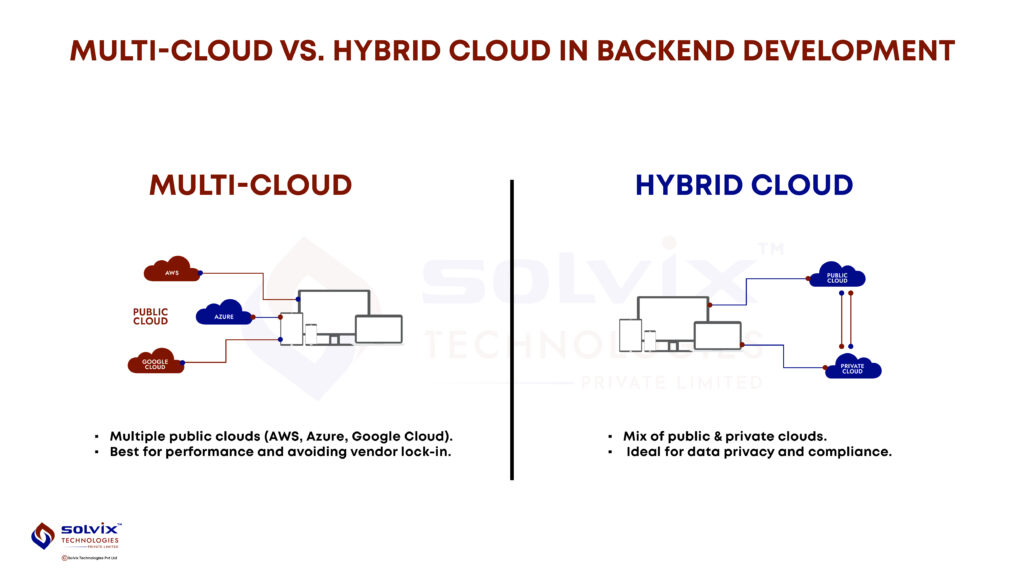No products in the cart.
The Shift to Multi-Cloud and Hybrid Cloud Strategies in Backend Development
It’s no secret that the digital world is getting… well, cloudier. As businesses lean heavily on tech to drive innovation and scale like never before, backend development isn’t just about clean code or sleek APIs anymore. It’s also about multi-cloud and hybrid cloud strategies—terms that have evolved from buzzwords to business necessities. If you’re wondering whether this shift is just another fleeting trend, spoiler alert: it’s not.
Why the Rush Toward Multi-Cloud and Hybrid Cloud?

First things first: why is everyone suddenly talking about multi-cloud and hybrid cloud strategies in backend development?
Simple. Companies crave flexibility. They want to avoid vendor lock-in (because who wants to be stuck with one provider forever?), maximize uptime, boost performance, and yes—get better deals.
With multi-cloud strategies, businesses tap into services from multiple cloud providers. Maybe they host critical databases on AWS, while running applications on Azure, and using Google Cloud’s machine learning tools. Why limit yourself to one chef when you can have a whole buffet?
Meanwhile, hybrid cloud strategies blend public and private clouds, offering the best of both worlds. It’s like having a swanky condo downtown (public cloud) and a cozy cabin in the woods (private cloud)—you pick where you want to stay based on your needs.
And for businesses exploring modern backend development services, cloud adaptability isn’t optional anymore—it’s core to delivering reliable and scalable solutions.
How Does This Impact Backend Development?
Backend developers now wear more hats than ever. Instead of just building a solid server-side app, they must design systems that seamlessly glide between cloud environments.
Here’s where the magic—and the challenge—happens:
- Interoperability: Systems must communicate flawlessly across different clouds and on-premises servers.
- Data synchronization: No one likes data silos or inconsistencies.
- Security: More environments = more risk. Encryption, identity management, and monitoring have leveled up.
- Scalability: Backend infrastructures must scale dynamically depending on the demands across multiple platforms.
In other words, the backend isn’t hiding quietly in a server room anymore. It’s out there in the wild, negotiating deals between cloud giants—and picking the best backend technologies for web development to survive and thrive.
Benefits of Adopting Multi-Cloud and Hybrid Cloud in Backend Development
You might ask, “Is the effort even worth it?” Short answer: absolutely. Here’s why backend developers and businesses are flocking toward these strategies:
1. Redundancy and Resilience
If one cloud provider has an outage (and yes, it happens even to the big ones), your app can reroute traffic through another. No downtime tantrums. No angry user tweets. Everyone’s happy.
2. Performance Optimization
Different clouds excel at different things. Some offer lightning-fast storage. Others specialize in advanced AI capabilities. Multi-cloud lets you mix and match to optimize performance across the backend.
3. Compliance and Data Sovereignty
Sometimes, regulations demand that data stays within specific countries. Hybrid cloud strategies allow companies to keep sensitive data private while leveraging public clouds for everything else.
4. Cost Management
When providers compete for your business, you win. Backend teams can choose services based on the best pricing models, discounts, or geographical benefits. Savvy businesses looking to hire backend developer teams who can master these cloud strategies are finding that it pays to invest in multi-skilled talent.
Challenges You Can’t Ignore
Of course, it’s not all sunshine and unicorns. Moving to a multi-cloud or hybrid cloud strategy brings its own hurdles:
- Complexity overload: Managing multiple clouds means more moving parts, more dashboards, more to monitor.
- Security blind spots: It’s easy to lose track of who’s accessing what, especially when juggling different platforms.
- Skill gaps: Not all developers are cloud-native wizards. Training and certifications are often needed.
- Data integration headaches: Ensuring seamless communication across clouds without latency or corruption is tough.
Best Practices for Backend Teams Moving Toward Cloud Strategies
If you’re planning to ride this multi-cloud wave, here’s how to avoid wiping out:
1. Design for Portability
Use containerization (think Docker, Kubernetes) to ensure apps can move effortlessly between cloud providers. Avoid vendor-specific tools that create stickiness.
2. Automate Like Your Job Depends on It
Automation isn’t just a buzzword—it’s survival. Use CI/CD pipelines, infrastructure as code (IaC), and automated monitoring to keep things humming across environments.
3. Prioritize Security from the Get-Go
Zero-trust models, encryption, authentication protocols—layer them in early. Don’t treat security like the boring broccoli side dish you skip.
4. Partner with Cloud-Agnostic Tools
Embrace tools and platforms that work across clouds—like Terraform, Datadog, and HashiCorp Vault. They’ll save your team a lot of heartache (and late nights).
5. Monitor Everything. And Then Monitor Some More.
Backend development in a multi-cloud or hybrid setup is dynamic. Real-time monitoring, smart alerting, and predictive analytics help you stay ahead of issues before they escalate.
Thus, The shift to multi-cloud and hybrid cloud strategies isn’t just backend evolution—it’s backend revolution. Developers today aren’t simply writing code; they’re architecting dynamic ecosystems that stretch across continents and providers.
FAQs About Multi-Cloud and Hybrid Cloud in Backend Development
Q: Is multi-cloud better than hybrid cloud?
Not necessarily. Multi-cloud focuses on leveraging multiple public cloud vendors, while hybrid cloud blends public and private clouds. The best choice depends on your business needs, security requirements, and existing infrastructure.
Q: Can a small business benefit from multi-cloud?
Absolutely. Even startups are embracing multi-cloud strategies to optimize costs and reduce risks. Many cloud providers offer scalable solutions perfect for small budgets.
Q: What skills are essential for backend developers in this new environment?
Cloud architecture basics, container orchestration, API management, security protocols, and automation tools top the list. Adaptability is the secret weapon, especially when choosing the right backend technologies for web development.
